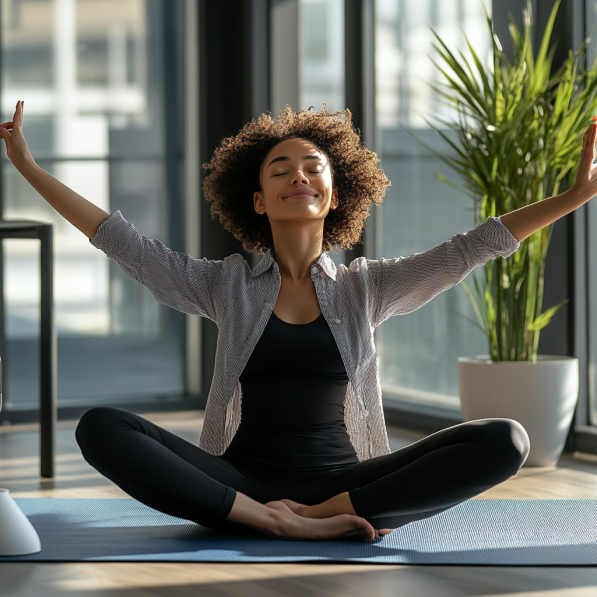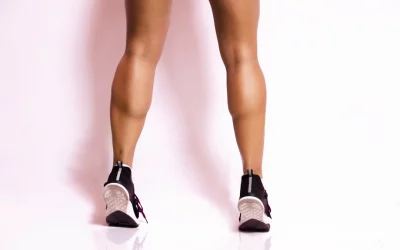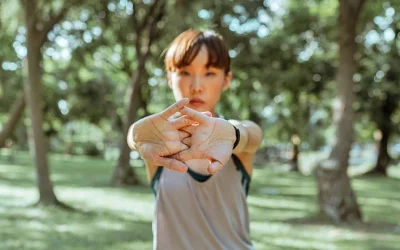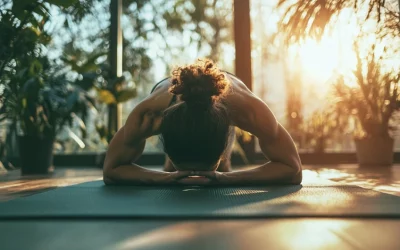Experiencing discomfort or tightness on just one side during the butterfly stretch can be a frustrating and confusing problem. It might make you worry there’s something wrong with your muscles or joints. Here’s something to put your mind at ease: you’re not alone—many people deal with this uneven feeling. Whether it’s a muscle imbalance, tight hips, or something else, identifying the root cause is the first step to solving the mystery.
This article explores the possible reasons for this annoying pain and how you can address it effectively.
What is the Butterfly Stretch?
The butterfly stretch is a seated exercise commonly used to improve hip flexibility and mobility. The basic process of the stretch is for the person to sit on the floor, bring the soles of their feet together, and let their knees relax outward toward the ground. This position creates a deep stretch through the hips, specifically targeting the inner thighs and groin.
The primary purpose of the butterfly stretch is to increase hip mobility by focusing on the inner thigh muscles, especially the adductors, which are responsible for bringing your legs together. Additionally, the stretch engages the hip flexors, helping to relieve tightness in the front of the hips. By practicing the butterfly stretch regularly, you can elevate your hip’s range of motion, which benefits many physical activities, from sports to everyday movements.
Common Causes of Butterfly Stretch Pain on One Side
Muscle Imbalance
Muscle imbalances are a common reason for experiencing uneven tension or discomfort during the butterfly stretch. When one side of your body is stronger or more flexible than the other, it can cause an uneven stretch, leading to pain or tightness on the weaker side.
For example, if your dominant leg (the one you use more often) is stronger or more flexible, the non-dominant leg might struggle to keep up. This imbalance can place extra strain on the muscles of the weaker side, making the stretch feel uncomfortable and uneven.
Muscle imbalances often show up in specific muscle groups. Two areas that commonly create issues during the butterfly stretch are:
-
Adductors: These are the muscles on the inside of your thighs. If the adductors on one side are weaker, you might feel more tension on that side during the stretch.
-
Glutes: If the glute muscles on one side are weaker, it can make it harder to stabilize your hips, leading to discomfort.
Hip Joint Restrictions
When you’re feeling discomfort on one side during the butterfly stretch, it might be because of hip joint restrictions. This happens when one hip has a limited range of motion, causing asymmetrical strain across your body. As you try to perform the stretch, the restricted hip can’t open up as much as the other side, leading to uneven pressure and discomfort.
One possible cause of this limitation is hip impingement. This condition occurs when the bones in your hip joint rub against each other in an abnormal way. The friction can result in reduced mobility, making it difficult to fully perform movements like the butterfly stretch without pain.
Another potential reason for restricted hip movement is osteoarthritis. This is a degenerative joint disease that often affects one hip more than the other. The stiffness and discomfort associated with osteoarthritis can make stretching exercises, especially ones as intense as the butterfly stretch, painful on the affected side.
Tight Hip Flexors and Muscle Tension
Tight hip flexors and overall muscle tension are common contributors to uneven discomfort during the butterfly stretch. When your hip flexors are tight, they limit your range of motion. This restriction can cause one side of your body to compensate, leading to an imbalance in how you feel the stretch.
Muscle tightness in the groin and surrounding areas can also cause strain. If one side of your groin is tighter, it can make that side feel more agonizing. This imbalance often happens when your muscles haven’t been stretched or worked out evenly.
In addition, general muscle tension throughout the hips, thighs, and lower back can affect how your body responds to the butterfly stretch. If these areas are tight, it becomes harder for your body to relax into the stretch, which can result in discomfort or pain on one side. Reduced flexibility leads to uneven sensations, especially when tight muscles pull more on one side than the other.
Previous Injury
Previous injuries can often lead to side-specific pain when performing the butterfly stretch. If you’ve had trauma to your hip, lower back, or leg, this history can play a role in the discomfort you’re feeling.
Injuries can leave behind scar tissue, which might restrict your range of motion. This limitation often makes stretching more uncomfortable, especially on one side of the body. Scar tissue tends to form in the muscles, tendons, or ligaments as part of the body’s healing process. While it helps in recovery, it can reduce flexibility, leading to a pulling sensation or pain during stretches like the butterfly stretch.
Injuries that weaken or reduce flexibility in certain muscles can also cause muscle imbalances. For example, if one hip or leg was injured and has become weaker, the stronger side will compensate.
Ultimately, the body doesn’t always recover symmetrically from injury, and this imbalance can reveal itself during stretches that involve both sides of the body equally.
Nerve Tension
When you experience nerve tension during the butterfly stretch, particularly involving the sciatic nerve, it can lead to discomfort or pain on one side of your body. The sciatic nerve runs from your lower back, down through your hips, and into your legs. If there’s tension or irritation in this nerve, it can cause a sharp or radiating pain, often felt in one leg.
A common condition that can lead to this kind of nerve tension is piriformis syndrome, where the piriformis muscle compresses the sciatic nerve. When this happens, you might feel a deep ache or tingling sensation on one side during the butterfly stretch. This is because the piriformis muscle sits near the sciatic nerve, and if it becomes too tight, it can press on the nerve, leading to discomfort.
Another factor is nerve impingement in the lower back or hips. This happens when the nerve gets pinched or irritated, often because of issues like a herniated disc or tight muscles around the hips. The result can be pain that radiates down one leg, making it hard to stretch evenly during the butterfly stretch.
Fixes for Butterfly Stretch Pain on One Side
Warm-Up and Gradual Stretching
Warming up and gradually easing into the butterfly stretch is important for preventing pain and improving flexibility. Starting cold can lead to tension or even injury, especially if one side of your body is already sensitive.
Begin with light dynamic exercises to get your hips and surrounding muscles ready for the stretch. Movements like leg swings, hip circles, or walking lunges can increase blood flow, helping to loosen up tight areas.
When you start the butterfly stretch, take it slow. Focus on gently increasing flexibility on both sides, instead of forcing your legs down. Move into the stretch gradually and feel for any tightness or resistance. If one side feels tighter, don’t push through it. Instead, ease into the stretch and work within your current range of motion.
Avoid bouncing or making sudden, jerky movements during the stretch. These actions can quickly lead to injury by putting too much strain on already tight or painful areas.
Strengthening Exercises
Strengthening your muscles is important for addressing one-sided pain during the butterfly stretch. By reinforcing key muscle groups, you can correct imbalances, improve stability, and reduce discomfort.
First, focus on hip abductors. These muscles play a key role in stabilizing your hips and legs. To strengthen them, try exercises like side-lying leg lifts or clamshells. These movements target the muscles that control hip stability and help reduce any one-sided strain you might feel.
Another critical area to work on is hip external rotation. Exercises like seated or lying hip external rotations can help increase flexibility and balance in both hips. This will allow you to stretch more comfortably and evenly.
Finally, strengthening your core muscles is important. A strong core supports proper posture and alignment, which helps distribute tension evenly during the butterfly stretch. Planks and leg raises are good exercises for this. A stable core means less pressure on one side of your body, reducing the chance of pain or tightness.
Foam Rolling and Massage
Foam rolling and massage therapy can be effective tools to relieve tension and discomfort in the hips during a butterfly stretch. If you experience one-sided pain, these methods might help loosen tight muscles that contribute to the imbalance.
Using a foam roller to target specific areas can release tension in the hip flexors. With regular use, foam rolling can help stretch and relax these muscles, making it easier to perform the butterfly stretch without discomfort.
You can also focus on foam rolling the glutes. By applying pressure to the glutes with a foam roller, you can work out knots and help balance the tension between both sides of your body.
For a deeper release, massage therapy can be beneficial. A massage therapist can manually relax the muscles around your hips and legs, which improves flexibility and reduces pain on the affected side. By breaking up tight spots, massage therapy promotes better muscle function and can help you stretch more comfortably.
Targeted Stretching for Hip Flexors and Piriformis
To deal with one-sided pain during the butterfly stretch, it’s important to focus on both hip flexors and the piriformis muscle. These muscles are often responsible for the discomfort you feel. Stretching them directly can help relieve tension and improve your range of motion.
For your hip flexors, the kneeling hip flexor stretch is an effective way to release tightness. To perform it:
-
Start in a kneeling position with one knee on the ground and the other foot forward, creating a 90-degree angle.
-
Push your hips forward gently while keeping your back straight.
-
Hold the stretch for up to 30 seconds, then switch sides. This stretch helps lengthen the hip flexors, which can ease one-sided discomfort in the butterfly position.
For the piriformis, the figure four stretch is useful to target this small but often tight muscle located deep in your buttock. Here’s how to do it:
-
Lie on your back and bend both knees.
-
Place your right ankle over your left knee, forming a “4” shape.
-
Reach behind your left thigh and gently pull it towards your chest, feeling the stretch in your right hip.
-
Hold for up to 30 seconds, then repeat on the other side.
This stretch addresses tightness in the piriformis that could be contributing to the asymmetrical pain you’re experiencing during the butterfly stretch.
Exercise Smarter with WeStretch: Your All-in-One Stretching Assistant
![]() A consistent full-body stretching routine is essential for improving flexibility, supporting injury prevention, and enhancing overall well-being. Carefully following simple yet effective stretches targeting the hamstrings, hip flexors, back, quads, chest, and shoulders, individuals of any fitness level can reap the benefits.
A consistent full-body stretching routine is essential for improving flexibility, supporting injury prevention, and enhancing overall well-being. Carefully following simple yet effective stretches targeting the hamstrings, hip flexors, back, quads, chest, and shoulders, individuals of any fitness level can reap the benefits.
Regular stretching, with attention to proper form and consistency, can help you move more freely, recover faster, and feel better in everyday activities.
Looking for a way to add some fun to your stretching routine? Check out WeStretch—an app that’s like your own personal stretch coach! With tailored plans, easy-to-follow demos, and progress tracking, it’s got everything you need to keep you limber and on point. Ready to get flexible? Sign up today and let’s get stretching!
FAQ
Why does it hurt when I do a butterfly stretch?
Pain during a butterfly stretch, especially on one side, often comes from muscle imbalances, tight hip flexors or adductors, or even issues in the lower back or pelvis. Inflexibility or overuse of one side might cause discomfort.
Additionally, past injuries, such as a pulled groin, can lead to tightness or irritation. To alleviate pain, focus on warming up, stretching gradually, and ensuring proper form. If discomfort persists, consider consulting a professional to rule out underlying issues.
Where should you feel the butterfly stretch?
During the butterfly stretch, you should mainly feel a gentle stretch in your inner thighs and groin area. If you’re experiencing pain or tightness on one side, it might indicate muscle imbalances, tight hip flexors, or even joint issues. This discomfort is not typical and can signal that one side of your body is compensating for the other.
Proper warm-ups, stretching, and addressing any underlying muscle imbalances can help alleviate the discomfort.
How do you alleviate the outer hip pain during the stretch?
Focus on maintaining a straight back and lean forward gently while keeping your knees as close to the ground as possible. Engage your core and avoid forcing the stretch. If one side is tighter, you can individually stretch that hip by crossing the affected leg over the opposite knee while seated and gently pressing down. This targets the outer hip muscles, helping to alleviate tightness over time.
Is butterfly stretch safe?
Yes, the butterfly stretch is generally safe when performed correctly. However, pain or tightness on one side might indicate muscle imbalances, tight hips, or underlying issues like piriformis syndrome. If you experience sharp or persistent pain, it’s important to stop and consult a healthcare professional. Always warm up before stretching and avoid pushing your body beyond its limits.
Why does my butterfly stretch hurt more on one side?
Uneven tightness or pain during the butterfly stretch can be caused by muscle imbalances, previous injuries, or natural differences in flexibility between your hips. Overuse, poor posture, or scar tissue in one leg or hip might also contribute to greater discomfort on one side.
Addressing this requires consistent stretching, strengthening weaker muscles, and proper warm-ups to improve flexibility and balance.






